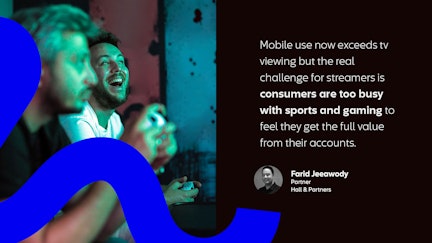Perspectives

Streaming brands are increasingly fighting for a share of consumer attention beyond their immediate competitors. It’s a challenge recently emphasised by the IPA showing that, for the first time, people spend more time on their mobile each day than watching tv. It’s only a five-minute difference – 3 hours 21 minutes for mobile vs 3 hours 16 minutes for tv – but it underlines mobile’s increasing pull-on consumer attention to future-proof streaming strategies.
It reinforces the need for streaming brands to engage with consumers beyond the tv screen but, despite the headlines, this should not be seen as a battle simply between tv and mobile, the so-called ‘scrolling vs streaming’ challenge. The bigger question centres around time. How do streaming brands prosper when consumers are reporting they are too busy to get the full value from the, typically, four subscriptions they hold?
This pressure on time was highlighted by recent Hall & Partners consumer research. It revealed 28% of UK and 30% of US streamers are more likely to cancel a service in the next six months than before. When asked why, price and content were major considerations, but so too are busy lives. Nearly one in four UK, and nearly one in three US, streamers say there are just not enough hours in the day to get the value from their accounts.
Drilling down, nearly one in three, 31%, US and one in six, 17%, UK consumers say they’re too busy with gaming or sports. This is where consumers’ attention is being spent away from the tv and it’s prompting consumers to be more likely to consider cancelling an account.

Four essential strategies streaming brands must focus on
1. How can streaming brands build stronger partnerships in gaming and sports?
Streaming brands are already starting to find ways to embrace and engage people with gaming and sports, but there is opportunity to take gaming and streaming services partnerships further to build strong relationships with customers.
Netflix is a first mover here, offering a games channel, including a selection that are intended to be played on mobile devices. It’s early days. Analysts at Omdia estimate only 0.45% of the time users spend on Netflix is devoted to gaming. Apple similarly has its Arcade which can be bundled with streaming, through an Apple One account. However, both examples are more extensions of a service, rather than a partnership that seeks to engage new customers.
The best idea of what a deeper partnership between streaming and gaming services could look like will come from Disney through its new deal with Epic Games, the developer behind the popular Fortnite game. When launched in late 2026 the new partnership will lead to Disney, Pixar, Marvel and Star Wars characters, storylines and settings being added to Fortnite. It is not just a new games tab on its home page but rather, what Disney calls, “an all-new games and entertainment universe”.
Just as with gaming, the main push from streamers in sport is to add new content, rather than empower each brand to be discovered away from the tv screen. Netflix has its WWE wrestling deal, Discovery is home to TNT sports and Apple has MLS rights in the USA. Amazon previously showed a limited number of Premier League games but still has a range of rights, including tennis and NBA. Just as with gaming, these content-led deals leave scope for closer ties with sporting organisations that extend beyond rights.
2. Why do streaming services need to rethink their media strategy for sports and gaming audience?
The realisation that key customer segments are too busy with sports or gaming to get full value from their streaming accounts, should also be prompting a rethink of media strategy. Traditionally streaming brands plan campaigns to reach new audiences through web sites and tv shows where entertainment news is discussed, as well as advertising on social media channels and using influencers who help people find their next ‘must watch’ show. The assumption behind this planning needs to be revised.
Instead, digital display and social media advertising should incorporate gaming and sports channels, and consideration should be given to in-play branding. This could include ramping up advertising around sporting arenas and at the pitch side, as well as in-game advertising for popular games. When it comes to social media influencers, streaming brands will need to reconsider whom they work with, perhaps looking beyond entertainment alone to consider working with authentic, trusted sources in the gaming and sports world.
Netflix recently dipped a toe in the water at Tottenham Hotspur with actors dressed up as characters from the hit show, Squid Game, interacting with fans. However, there remains a potentially untapped opportunity to expose gamers and sports fans to streaming brands through advertising within games and stadia, as well as the sites and communities that fans visit.
Streaming brands should consider launching their own fan sites and pages on the internet and social media. These would be a means to keep viewers loyal as well as attract new audiences in new settings. Fans often set these sites up for a favourite show but brands running their own sites and social pages would circumnavigate the problem of a tv show page building an audience that moves with them if rights shift to another provider.
3. What role does snackable mobile content play in the future of streaming?
Streamers should reconsider content curation strategies by tapping into how people consume bite size/short form media and content in the digital, mobile era. While brands offer movies and lengthy multi-episode documentaries and dramas, mobiles are normally used for shorter form content, such as social media videos or YouTube.
That’s why streamers need to look more into offering more bite size, ‘snackable’ video. This could tap into gaming and sports with highlights of matches or gaming tips, alongside interviews with athletes and gamers. The content options are almost limitless and could even include dramas offered in ten minutes segments.
4. How should streaming brands remeasure success beyond subscriber numbers?
A huge takeout from the recent Hall & Partners research is that people are twice as likely to cancel a service over the next six months as they are to open a new one. To prosper against the backdrop of churn, streamers need to look beyond today’s devotion to subscriber numbers. They are obviously hugely important, but they don’t tell the full story.
Brands need to start looking at social buzz and brand sentiment to understand how they are going to be impacted when people start switching off. In addition to measuring how many customers they have, and how long they are spending watching shows, streamers need to evaluate their brand equity holistically including emotional and rational engagement and behavioural metrics such as advocacy and sharing.
They need to look at these metrics and compare them with rivals to ensure they are ahead in the social buzz and customer sentiment measures that will help prosper while other services risk being cancelled. They also need to consider cross-category measurement so they can establish how they compare to a top sport or team as well as a leading games title. Comparing how consumers feel about their own brand vs, say, Call of Duty, would allow streamers to get under the skin of consumers and understand where the gaps are that could build a stronger bond and fuel brand growth.
It's important because streamers know they must reach out to attract new audiences. That’s why Disney and ITV have signed a content deal in the UK and Netflix has done the same with TF1 in France. This move towards partnership and branding campaigns must go deeper and extend to sports and gaming scenarios. It should also be tuned into where attention is moving to. That means mobile communities and social campaigns as well as augmenting the all you can eat buffet service they offer on the television with bite-size snacks to be consumed on the smaller screen, often on the move.
Talk to our team of experts
Learn how we can deliver actionable insights and creativity to drive brand growth.








